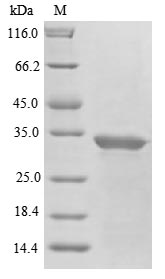Recombinant Abrus precatorius Abrin-a generation initiates with isolating the target gene corresponding to the Abrus precatorius Abrin-a (1-251aa). This gene is co-cloned into an expression vector with an N-terminal 10xHis-tag gene and introduced into E. coli cells via transformation. The positive E. coli cells are induced to express the recombinant protein, which is harvested from the cell lysate. The protein is purified using affinity chromatography. Its purity is over 85% as determined by SDS-PAGE.
Abrin-a is a protein toxin derived from the seeds of the plant Abrus precatorius, commonly known as jequirity beans or rosary peas. This toxin is a type II ribosome-inactivating protein that inhibits protein synthesis in eukaryotic cells, leading to cell death [1][2][3][4][5][6][7]. Structurally and functionally, abrin-a is similar to ricin, a protein toxin found in castor beans [8]. It acts as a ribosome inhibitory protein, with an enzymatic A chain linked to a B chain, which has specificity to terminal galactose [3]. Abrin-a has gained attention due to its potential malevolent use and is of concern as a biothreat agent [9]. The toxin triggers apoptosis in cells by inhibiting protein synthesis, leading to the unfolded protein response [4]. Additionally, abrin-a has been the focus of research for developing detection methods, quantification techniques, and even post-exposure protection strategies against its toxicity [5][10].
References:
[1] B. Hovde, H. Daligault, E. Hanschen, Y. Kunde, M. Johnson, S. Starkenburget al., Detection of abrin-like and prepropulchellin-like toxin genes and transcripts using whole genome sequencing and full-length transcript sequencing of abrus precatorius, Toxins, vol. 11, no. 12, p. 691, 2019. https://doi.org/10.3390/toxins11120691
[2] A. Bagaria, K. Surendranath, U. Ramagopal, S. Ramakumar, & A. Karande, Structure-function analysis and insights into the reduced toxicity of abrus precatorius agglutinin i in relation to abrin, Journal of Biological Chemistry, vol. 281, no. 45, p. 34465-34474, 2006. https://doi.org/10.1074/jbc.m601777200
[3] S. Gadadhar and A. Karande, Abrin immunotoxin: targeted cytotoxicity and intracellular trafficking pathway, Plos One, vol. 8, no. 3, p. e58304, 2013. https://doi.org/10.1371/journal.pone.0058304
[4] R. Mishra, M. Kumar, & A. Karande, Inhibition of protein synthesis leading to unfolded protein response is the major event in abrin-mediated apoptosis, Molecular and Cellular Biochemistry, vol. 403, no. 1-2, p. 255-265, 2015. https://doi.org/10.1007/s11010-015-2355-9
[5] S. Livet, S. Worbs, H. Volland, S. Simon, M. Dorner, F. Fenailleet al., Development and evaluation of an immuno-maldi-tof mass spectrometry approach for quantification of the abrin toxin in complex food matrices, Toxins, vol. 13, no. 1, p. 52, 2021. https://doi.org/10.3390/toxins13010052
[6] J. Wooten, C. Pittman, T. Blake, J. Thomas, J. Devlin, R. Higgersonet al., A case of abrin toxin poisoning, confirmed via quantitation of l-abrine (n-methyl-l-tryptophan) biomarker, Journal of Medical Toxicology, vol. 10, no. 4, p. 392-394, 2014. https://doi.org/10.1007/s13181-013-0377-9
[7] S. Banger, R. Singh, N. Tripathi, V. Pal, & A. Goel, One step purification and characterisation of abrin toxin from abrus precatorius seeds, Defence Life Science Journal, vol. 4, no. 4, p. 231-235, 2019. https://doi.org/10.14429/dlsj.4.14967
[8] M. Kumar, P. Dinkar, H. Abbas, & E. Chaudhary, Fatal curiosity: a case of suicidal attempt by abrus seeds consumption through online research, Cureus, 2023. https://doi.org/10.7759/cureus.38458
[9] A. Dodge, K. Carrasquillo, L. Rivera, X. Lei, L. Wackett, & M. Sadowsky, Rapid method using two microbial enzymes for detection of l-abrine in food as a marker for the toxic protein abrin, Applied and Environmental Microbiology, vol. 81, no. 5, p. 1610-1615, 2015. https://doi.org/10.1128/aem.03492-14
[10] A. Mechaly, R. Alcalay, T. Noy-Porat, E. Epstein, Y. Gal, & O. Mazor, Novel phage display-derived anti-abrin antibodies confer post-exposure protection against abrin intoxication, Toxins, vol. 10, no. 2, p. 80, 2018. https://doi.org/10.3390/toxins10020080








